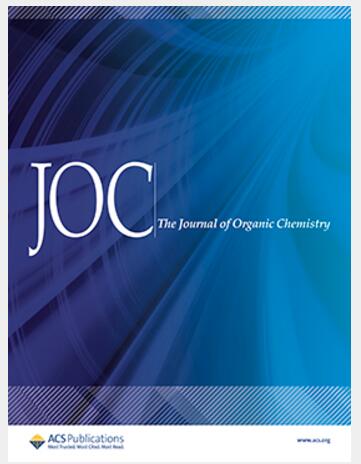1,3-二碘双环[1.1.1]戊烷的亲核取代:双环[1.1.1]戊基吡啶、喹啉、异喹啉和吡唑盐的合成
IF 3.6
2区 化学
Q1 CHEMISTRY, ORGANIC
引用次数: 0
摘要
本研究描述了1,3-二多二环[1.1.1]戊烷(DIBCP)与几种亲核试剂的亲核反应合成双环[1.1.1]戊烷盐。双环[1.1.1]戊烷片段是已建立的丁基、炔基和1,4-二芳基结构单元的同位异构体,其合成通常通过加入不稳定的、低温储存的[1.1.1]推进剂前驱体来实现。相比之下,DIBCP是一种稳定的结晶固体,有可能成为合成BCP片段的原料。本工作提供了一条简单实用的合成双[1.1.1]戊基吡啶、喹啉、异喹啉和吡唑盐的途径。这种转变显示出广泛的衬底范围,良好的产率曲线,其中一些BCP产品被单晶x射线晶体学完全表征。该反应是通过亲核取代1,3-二多双环[1.1.1]戊烷(DIBCP)进行的,我们提供了详细的计算分析,显示了两种亲核试剂在稳定关键碳阳离子中间体中的作用。合成的盐是现有芳基吡啶和芳基喹啉盐的同分异构体,用于制药和工业化学部门的高价值商品化学品。最后,研究了这些盐的合成用途,为n-吡啶-4- 1和n-喹啉-4- 1取代的双环[1.1.1]戊烷提供了实用的合成路线。本文章由计算机程序翻译,如有差异,请以英文原文为准。
![Nucleophilic Substitution of 1,3-Diiodobicyclo[1.1.1]pentane: Synthesis of Bicyclo[1.1.1]pentylpyridinium, Quinolinium, Isoquinolinium, and Pyrazolium Salts](https://img.booksci.cn/booksciimg/2025-5/2025052910384052530159.png)
Nucleophilic Substitution of 1,3-Diiodobicyclo[1.1.1]pentane: Synthesis of Bicyclo[1.1.1]pentylpyridinium, Quinolinium, Isoquinolinium, and Pyrazolium Salts
In this study, we describe the synthesis of bicyclo[1.1.1]pentane salts by the nucleophilic reaction of 1,3-diodobicyclo[1.1.1]pentane (DIBCP) with several classes of nucleophiles. The bicyclo[1.1.1]pentane fragments are established isosteres for tbutyl, alkynyl, and 1,4-diaryl structural units, whose synthesis is typically achieved by addition to the unstable, cryogenically stored, [1.1.1]propellane precursor. In contrast, DIBCP is a stable crystalline solid, with the potential to be a feedstock in the synthesis of BCP fragments. This work provides a straightforward, practical synthetic route to bicyclo[1.1.1]pentylpyridinium, quinolinium, isoquinolinium and pyrazolium salts. This transformation displays a broad substrate scope, good yield profile, with several of the BCP products being fully characterized by single-crystal X-ray crystallography. The reaction proceeds by nucleophilic substitution on 1,3-diodobicyclo[1.1.1]pentane (DIBCP), and we provide detailed computational analysis, showing the role of two nucleophiles in stabilizing a key carbocation intermediate. The synthesized salts are isosteres of existing arylpyridinium and arylquinolinium salts used within pharmaceuticals and high-value commodity chemicals within the industrial chemical sector. Finally, the synthetic utility of these salts is examined, providing practical synthetic routes to N-pyridin-4-one and N-quinolin-4-one substituted bicyclo[1.1.1]pentanes.
求助全文
通过发布文献求助,成功后即可免费获取论文全文。
去求助
来源期刊

Journal of Organic Chemistry
化学-有机化学
CiteScore
6.20
自引率
11.10%
发文量
1467
审稿时长
2 months
期刊介绍:
Journal of Organic Chemistry welcomes original contributions of fundamental research in all branches of the theory and practice of organic chemistry. In selecting manuscripts for publication, the editors place emphasis on the quality and novelty of the work, as well as the breadth of interest to the organic chemistry community.
 求助内容:
求助内容: 应助结果提醒方式:
应助结果提醒方式:


